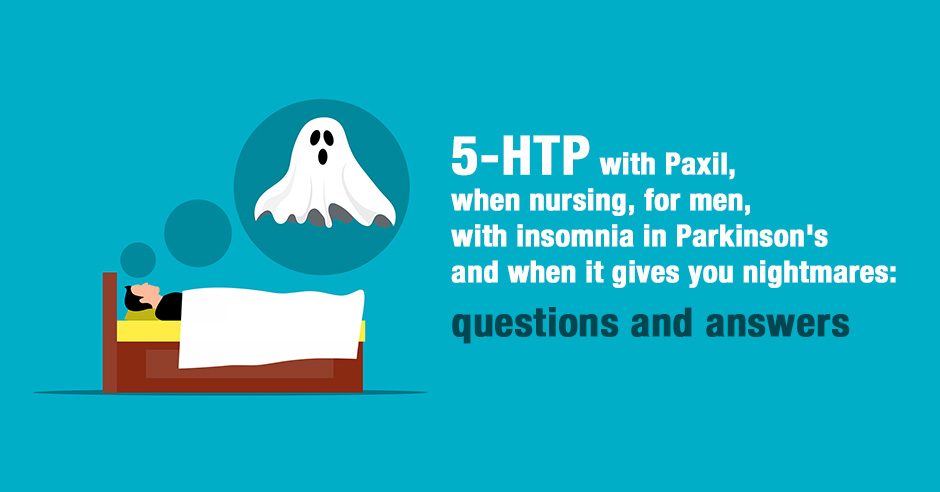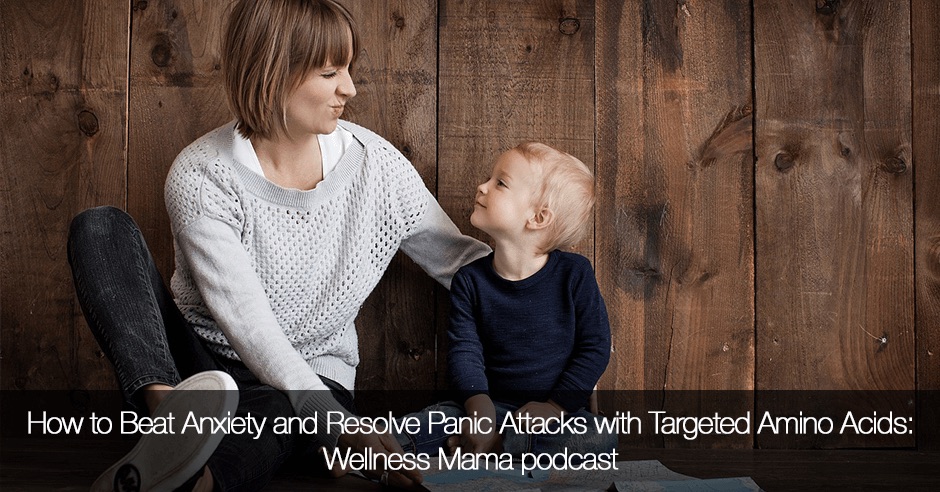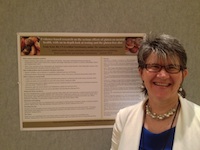
5-HTP is an amino acid, made from the seeds of an African plant, Griffonia simplicifolia, and used as a supplement to ease low serotonin symptoms of worry-type anxiety, often with ruminations, obsessing and panic attacks. When you have insomnia caused by low serotonin you may lie awake worrying. This type of anxiety is different from the low GABA physical/tension type anxiety. Other low serotonin symptoms include low mood/depression, late afternoon and evening carbohydrate cravings, pain, digestive/IBS symptoms, PMS, irritability, rage and anger, TMJ, low confidence, imposter syndrome and perfectionism.
I’ve blogged about 5-HTP extensively and I receive many great questions about this supplement. Today I’m going to share some of these questions and my answers so you can get the benefits too: using it with Paxil, insomnia when you have Parkinson’s disease, if 5-HTP works for men, timing of 5-HTP with nightmares and if 5-HTP can be used in pregnancy and when nursing.
Haley shared how 5-HTP helps with insomnia and asks about taking it with Paxil:
I was taking 5-HTP and it definitely helped me sleep at night. I recently started Paxil for my panic attacks after a recent trauma and I’m no longer sure if I can take Paxil with 5-HTP or not?
I’m so glad to hear 5-HTP helped with sleep. I’m sorry to hear about your recent trauma but keep in mind the other benefits of 5-HTP – helping with panic attacks is just one. When I’m working with someone who has experienced something like this and is already seeing benefits with 5-HTP, we increase their 5-HTP to help with the panic attacks too.
If they have already started Paxil and would prefer to stop using it I have them read this tapering blog and work/discuss with their prescribing doctor. There is the risk of serotonin syndrome with SSRIs (such as Paxil) and 5-HTP (and tryptophan).
There are many nutritional solutions for trauma and psychological stress (a natural disaster or anything else) and we’d address all this too.
Lynn has Parkinson’s disease and sleep problems:
I have Parkinson’s and sleep is starting to be an issue. I usually fall asleep but after about 4 hours I’m wide awake. I’m afraid this sleeplessness will negatively affect my brain if I can’t remedy this. I take carbidopa/levodopa. I’ve seen a sleep neurologist and she wants to prescribe drugs which again I’m afraid will have a negative effect on my brain. Your suggestions around 5-HTP would be very much appreciated.
We always start with the low serotonin symptoms and do a trial of either 5-HTP or tryptophan if it looks like low serotonin is the root cause of the sleep issues (there are many other root causes of insomnia).
If you score high on many of the low serotonin symptoms I suggest sharing this 5-HTP/Parkinson’s disease blog post and research with your sleep neurologist and Parkinson’s doctor: “Research shows that the amino acid 5-HTP (5-hydroxytryptophan), the intermediate metabolite of tryptophan in the production of serotonin, offers benefits for Parkinson’s disease patients. It has been reported to ease depression and to reduce levodopa-induced motor complications. This was reported in two separate studies by the same research team at the University of Cagliari, Cagliari, Italy. They were small studies and considered preliminary.”
Meleah asks about using 5-HTP with men:
Hi Trudy, did you recommend the same protocol for men? Most of the examples are about women and I have a male friend who needs help
Generally speaking the amino acids work the same for men but I have found that the impact they have on the sex hormone estrogen when using 5-HTP or tryptophan (and progesterone when using GABA) means they tend to work exceptionally well for women.
I also have much more experience working with women so I have more to share on these outcomes. With the few men I have worked with I find they tend to under-report when looking at their low serotonin symptoms so this needs to be taken into account when doing the trial of 5-HTP or tryptophan.
Scott shared how he uses 5-HTP for insomnia and his solution for preventing nightmares when using it:
In regards to nightmares with 5-HTP, I definitely seem to experience disturbing dreams when I take it within 4 hours of bedtime. Therefore, I normally don’t take any after 7pm but do take it periodically throughout the day.
I also suggested it to a friend who tried and likes it very much, however, he experienced excessive dreaming which interferes with him sleeping soundly, so I suggested the same protocol to him.
When I was in college, I am now a senior, I tried taking regular tryptophan and soon started having nightmares and hallucinations as I began seeing faces on the wall when I was trying to fall asleep.
I only take 5-HTP now, in extended release 200mg tablets from the Natrol company. Thank you, Trudy, for bringing this subject up.
I thanked him for sharing this interesting nuance of nightmares with 5-HTP and using it in the day instead. (which I blogged about here i.e. some folks do get nightmares when using 5-HTP)
I’m glad he figured this out and it helps since tryptophan does cause him nightmares. We are all so different and have to find what works best for our unique needs.
Carly asks about using 5-HTP when nursing:
Can someone take 5-HTP while nursing?
5-HTP has not been studied during pregnancy or nursing but a free form amino acid blend that does contain tryptophan is often very helpful. You have to really look for these because many companies choose to leave out tryptophan. I have a few listed on the supplements blog.
Other approaches to improve mood, reduce anxiety and help with sleep while nursing include exercise, yoga, diet and bright light therapy/full spectrum light. Dr. Aviva Romm writes about herbs for anxiety and specifies which are safe while nursing.
If you are new to other anxiety nutrition solutions like gluten/sugar/caffeine removal, blood sugar control, gut health, and pyroluria my book “The Antianxiety Food Solution” is a great place to start for the foundations. Much of this helps with low mood, cravings and insomnia too. More here.
5-HTP is often successfully used in conjunction with other amino acids
Here are some useful blogs related to low serotonin and 5-HTP. As you can see, it’s often successfully used in conjunction with other amino acid supplementation:
- You can see all the low serotonin symptoms here.
- Fibromyalgia: tryptophan or 5-HTP for anxiety, depression, pain and insomnia
- GABA is a life saver for anxiety, theanine helps at night (insomnia) and 5-HTP makes a significant difference in lessening daily pain
- Drastic reduction in intrusive thoughts, anxiety and fears (and better sleep) with GABA, tryptophan, 5-HTP and the pyroluria protocol
- If low GABA type anxiety and insomnia is also an issue you may find this helpful too – GABA for easing physical anxiety and tension: some questions and answers.
- An amino acid supplement with DLPA, glutamine and 5-HTP eases alcohol withdrawal symptoms at an inpatient detoxification program
- You can see the 5-HTP and tryptophan products (and GABA) I use with my clients here on the supplements blog.
As always, it’s not only the low serotonin we need to address. 5-HTP offers quick relief but we must always do a full functional workup looking at diet, nutritional deficiencies, digestion, all hormones, toxins and infections (and so on) so we can address all possible root causes – and why serotonin is low in the first place.
I also want to add that I typically start with tryptophan for low serotonin support simply because I have such good results with it and because 5-HTP can raise cortisol in some folks. If we already have salivary cortisol results and none of the four collections are high then 5-HTP is an option to consider.
Resources if you are new to using 5-HTP and other amino acids as supplements
If you are new to using 5-HTP or any of the other amino acids as supplements, here is the Amino Acids Mood Questionnaire from The Antianxiety Food Solution (you can see all the symptoms of neurotransmitter imbalances, including low GABA and low serotonin).
If you suspect low levels of any of the neurotransmitters and do not yet have my book, The Antianxiety Food Solution – How the Foods You Eat Can Help You Calm Your Anxious Mind, Improve Your Mood, and End Cravings, I highly recommend getting it and reading it before jumping in and using amino acids on your own so you are knowledgeable. And be sure to share it with the practitioner/health team you or your loved one is working with.
There is an entire chapter on the amino acids and they are discussed throughout the book in the sections on gut health, gluten, blood sugar control, sugar cravings, self-medicating with alcohol and more.
The book doesn’t include product names (per the publisher’s request) so this blog, The Antianxiety Food Solution Amino Acid and Pyroluria Supplements, lists the amino acids that I use with my individual clients and those in my group programs. You can find them all in my online store.
If, after reading this blog and my book, you don’t feel comfortable figuring things out on your own (i.e. doing the symptoms questionnaire and respective amino acids trials), a good place to get help is the GABA QuickStart Program (if you have low GABA symptoms). This is a paid online/virtual group program where you get my guidance and community support.
If you are a practitioner, join us in The Balancing Neurotransmitters: the Fundamentals program. This is also a paid online/virtual program with an opportunity to interact with me and other practitioners who are also using the amino acids.
Thanks to these folks for asking good questions and for allowing me to share here.
What questions do you have about 5-HTP?
Which low serotonin symptoms can you relate to and has 5-HTP or tryptophan helped? Or have you found success with a combination?
Feel free to post your questions and feedback in the comments below.


